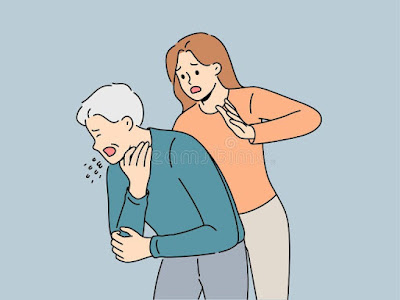Choking
 |
| Choking |
Choking is a life-threatening emergency that occurs when an object blocks the airway, preventing the passage of air into the lungs. When a person chokes, the body's natural response is to cough in an attempt to dislodge the obstruction. However, if the object remains stuck, it can lead to severe respiratory distress and even death.
The pharynx, larynx, trachea, and bronchi are key anatomical structures involved in choking. The pharynx serves as a passage for food and air, but when an object enters larynx instead of moving down the esophagus, it can block the airway. The larynx houses the vocal cords and can spasm during choking, further obstructing airflow. The trachea carries air from the larynx to the lungs, but if an object becomes lodged in this tube, it prevents oxygen from reaching the lungs. The bronchi branch off from the trachea and deliver air to the lungs, but if they are blocked, breathing becomes severely compromised.
Prompt action is crucial in a choking situation to clear the airway and restore normal breathing. Techniques such as the Heimlich maneuver or back blows can be used to dislodge the obstruction and save a person's life. It is essential to stay calm, act quickly, and seek medical attention if choking persist
Hypoxia due to choking occurs when an object obstructs the airway, preventing the flow of oxygen to the lungs. As a result, the body is deprived of essential oxygen, leading to a condition known as hypoxia. Without an adequate oxygen supply, cells in the body are unable to function properly, which can have serious consequences.
In cases of severe choking, where the obstruction is not quickly removed, hypoxia can progress rapidly. The lack of oxygen can cause symptoms such as confusion, dizziness, rapid heartbeat, and difficulty breathing. If left untreated, hypoxia can lead to irreversible damage to vital organs, including the brain, heart, and lungs.
How to treat choking
The Heimlich maneuver, also known as abdominal thrusts, is a technique used to help dislodge an obstruction from a person's airway in cases of choking. Here is a step-by-step guide on how to perform the Heimlich maneuver:
1. Stand behind the person who is choking and wrap your arms around their waist.
2. Make a fist with one hand and place the thumb side of your fist against the person's abdomen, slightly above the navel and below the ribcage.
3. Grasp your fist with your other hand and press inward and upward in a quick, forceful motion. The goal is to create enough pressure to dislodge the obstruction from the airway.
4. Repeat the abdominal thrusts until the object is expelled or the person can breathe again. Be sure to check the person's mouth for any remaining obstructions.
5. If the person becomes unconscious, carefully lay them on their back and start CPR. Check for breathing and perform rescue breaths if necessary.
It's important to note that the Heimlich maneuver should only be performed on someone who is conscious and showing signs of choking. If the person is unable to breathe, cough, or speak, and their face turns blue, it indicates a severe blockage, and immediate action is required.
If you are unsure about performing the Heimlich maneuver or if the person's condition worsens, call emergency services for further assistance. It's always recommended to take a first aid course to learn proper techniques for responding to choking emergencies and other medical situations.

